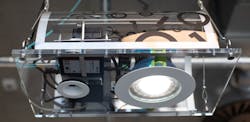Britain’s Institute of Physics kicks the Li-Fi tires
In the latest showcase of Internet delivered by light, Britain’s esteemed Institute of Physics (IOP) is giving the technology a little go at its brand new London home, in partnership with Edinburgh-based pureLiFi.
The IOP has installed four Li-Fi ceiling luminaires covering about a quarter of a 1200-ft2 co-working and private office section known as the IOP Accelerator Centre, dedicated to entrepreneurs who are hatching physics-related business ideas.
The Accelerator is lending specially equipped laptops to registered members. PureLiFi has outfitted the laptops with USB dongles that plug into the laptops and enable two-way Internet communications with the LED lights, which come from pureLiFi partner Lucibel, based in Barentin, France.
Li-Fi, or light fidelity, uses LED light waves to transmit data and access the Internet. By comparison, Wi-Fi uses radio waves.
Li-Fi proponents say that Li-Fi will help alleviate the spectrum crunch and the wavelength clashes that are increasingly plaguing Wi-Fi. They also note that Li-Fi is more secure, because the light waves do not spread or travel through walls. And since Li-Fi transmitters can reside in every light in a room, service speeds will not degrade the way they do when many users pile onto a single Wi-Fi node.
The IOP opened the Accelerator in April, a few months after its late 2018 move into the modern building, where operations tap many examples of applied physics such as solar panels, ground pumps for heat, thermal storage concrete, and a “blue green roof” that features plants and water storage.
With Li-Fi, IOP is now adding another bit of innovative physics engineering.
“We’re delighted to be launching the Li-Fi Demonstrator at the IOP’s new Accelerator Centre today,” said IOP CEO Paul Hardaker at the ceremonial opening of the service, timed to coincide with the International Day of Light. “Li-Fi is a superb example of how innovations in physics have the potential to resolve 21st century problems.”
Hardaker shared the stage with pureLiFi co-founder Harald Haas, a professor of mobile communications at the University of Edinburgh.
“The IOP is exactly the right place for an update on our vision since it is physics that tells us that radio waves and light waves belong to the same family, and it is, therefore, only logical to consider light waves to build future wireless communication systems,” Haas said.
In an unusual setup, the IOP feeds the Lucibel lights with the Internet via fiberoptic lines and powers the lights with standard electricity cable. Another method, among others, would be to connect the lights to the Internet via Ethernet cable that also carries low-voltage electricity, in a Power over Ethernet scheme, such as what Singapore’s Republic Polytechnic is doing in a Li-Fi deployment supplied by Signify.
At the IOP, an access point next to the luminaire receives data from the fiber feed and modulates the light for transmission to the user dongles, which transmit back via infrared.
PureLiFi began designing the IOP system last year, and has thus installed a system rated at a speed of 43 Mbit/s, which was the Scottish company’s top speed at the time. It recently demonstrated speeds of 1 Gbit/s.
Li-Fi in the past has often been wrongly represented as much faster than Wi-Fi. In practical operating terms, the two have been on a par, although Li-Fi now seems to be picking up a speed advantage. And, again, it also has the benefit of allowing users to naturally cram more transmitters into a space than Wi-Fi does, given that the Li-Fi chips are embedded in the lights, thus increasing the chances of keeping up the speeds on a busy day.
Still, Li-Fi remains in a prolonged pilot stage (pureLiFi itself dates back to 2012), in no small measure because Li-Fi typically requires a laptop, tablet, or gadget user to attach a dongle, whereas Wi-Fi has long been embedded.
While vendors such as pureLiFi have miniaturized the electronics such that they can reside inside gadgets, gadget makers have thus far resisted. That might change by 2021, the year that international standards body IEEE is expected to finally ratify a Li-Fi standard. As with any standards effort, the protracted deliberations have reportedly been characterized by industry in-fighting.
Li-Fi enthusiasts including pureLiFi say the technology will help offload the burden on Wi-Fi, which could rapidly run out of space as billions of devices connect to the burgeoning Internet of Things (IoT), weighing down Wi-Fi’s limited radio spectrum. Haas routinely points out that Li-Fi potentially adds 300 THz of spectrum compared to Wi-Fi’s 300 GHz, a difference of 1000×.
Thus, some people consider it an integral part of 5G, the next step up in general wireless technology, expected to arrive this year or next.
MARK HALPER is a contributing editor for LEDs Magazine, and an energy, technology, and business journalist ([email protected]).

Mark Halper | Contributing Editor, LEDs Magazine, and Business/Energy/Technology Journalist
Mark Halper is a freelance business, technology, and science journalist who covers everything from media moguls to subatomic particles. Halper has written from locations around the world for TIME Magazine, Fortune, Forbes, the New York Times, the Financial Times, the Guardian, CBS, Wired, and many others. A US citizen living in Britain, he cut his journalism teeth cutting and pasting copy for an English-language daily newspaper in Mexico City. Halper has a BA in history from Cornell University.





